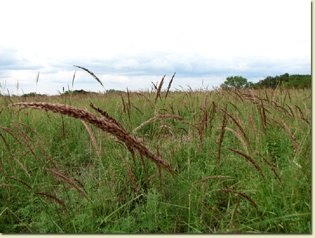




This grass may not look so remarkable to you, but considering the drought we've been in, this is downright lush! We'll have our irrigation system set up within another month or so, and we are very excited! Our pasture raised cattle enjoy roaming over quite a bit more property than we'd like at the moment, but it's the only way to make sure they have access to all the fresh "salad" they need to be happy and healthy. Once the irrigation system is set up, they'll have lusher grasses to feed on and we'll begin implementing our paddock system which means they won't be roaming as much but they'll have lusher, richer, more nutritious grasses to graze on. Oddly enough, cows eat better when they are in a paddock (huge paddocks, and a new one every day mind you) than when they are roaming several hundred acres. Competitive, I guess!
As good as the meat is now, I'm curious to see how much the taste of it improves when they don't have to wander quite so far to graze. For more photos or information, visit Our Website. We're also HERE on Facebook and you can get instant updates from us by following Us On Twitter.
Cooking Grass Fed Beef:
Want a tip on cooking a fantastic steak on the stove top? I do this frequently with everything from round steak to flank steak to T-bones. If you don't have a good vent-a-hood, you will likely fill your house with a bit more smoke than you like and you may prefer to avoid this technique unless your windows are open, but a smoking hot iron skillet makes a fantastic indoor steak.
Grass fed beef is so good and flavorful that I don't marinate the steaks or do anything much at all to them except maybe trim them up a bit. I never cut the fat off (because I like the fat) but if there is fat around the steak it's wise to make slits along it so the meat doesn't curl up as it cooks--then it won't cook evenly. The fat will cook faster than the meat and will try to curl up like bacon if you haven't made the slits, curling the steak along with it.
So, your iron skillet is on the stove on medium high to high heat. Throw salt right into the pan, as much as you think you would have used to season the steak if you were using it directly on the meat. Let the pan heat 5 to 7 minutes. The salt will season the meat perfectly and will actually make cleaning up the pan a little easier (so will a little water poured into it while it's still hot). When the pan is ready, throw your steak into the pan, raw and unadulterated. Don't touch it until it's time to turn it. I like my meat rare, so I don't usually have to wait long. Flip it, let it finish up, then lay it on a plate and cover it with another plate (turned upside down) and let it sit for two minutes before serving. This allows the juices to disperse evenly through the meat and makes for a juicier steak. Hubby prefers Worcestershire Sauce on his steak, I'll never understand that man. Myself, I like a dab of butter, coconut oil, or maybe some horseradish. Just a bit, mind you, I love the taste of grass fed beef and don't like covering it up with anything.
A word on the flavor of grass fed beef. I thought I knew how flavorful it was until I was making a roast, rotisserie style, and forgot to add salt to the meat. I had rubbed it with olive oil and let it marinade in beer overnight, then covered it with fresh crushed pepper before cooking it. But I just plain forgot to use salt. I LOVE salt and I eat way too much of it. I think I've developed a resistance to the taste of it and find myself using more and more of it. But on this roast, even leftover a couple of days later, I didn't miss the salt at all. Flavor flavor flavor, that's one of the wonderful things about pasture raised beef.










